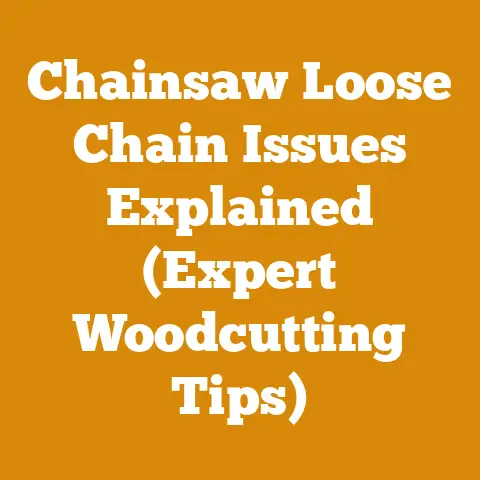450 Rancher Chain Guide (5 Pro Tips for Bar & Chain Upgrade)
450 Rancher Chain Guide: 5 Pro Tips for Bar & Chain Upgrade & Investment Breakdown
The heart of any successful wood processing operation, whether it’s felling trees in the forest or bucking logs for winter warmth, often lies in the reliability and efficiency of your chainsaw.
For many, the Husqvarna 450 Rancher represents a sweet spot: powerful enough for demanding tasks, yet manageable for extended use.
But even the best tools can be improved.
Upgrading the bar and chain on your 450 Rancher can dramatically enhance its performance, making it cut faster, smoother, and last longer.
However, it’s not just about bolting on the shiniest new parts.
It’s about making an informed investment.
Understanding the Investment: Beyond the Sticker Price
Before we dive into the technical details of bar and chain upgrades, let’s talk about investment.
It’s easy to focus solely on the initial purchase price.
However, a true investment considers the long-term benefits and costs.
A cheaper bar and chain might save you money upfront, but if it wears out quickly, requires frequent sharpening, or doesn’t cut efficiently, you’ll end up spending more in the long run on replacements, downtime, and wasted fuel.
Think of it like this: I once worked with a small logging crew in the Pacific Northwest.
They were using bargain-basement chains on their saws, thinking they were saving money.
However, they were constantly stopping to sharpen or replace chains, slowing down production significantly.
When they finally switched to higher-quality chains, their productivity soared, and they actually ended up saving money despite the higher initial cost.
Therefore, we need to look beyond the initial price tag and consider factors like:
- Durability: How long will the bar and chain last under typical use?
- Cutting Efficiency: How quickly and cleanly will it cut through different types of wood?
- Maintenance Requirements: How often will it need sharpening or other maintenance?
- Fuel Consumption: Will it help improve the saw’s fuel efficiency?
- Safety: Does it offer enhanced safety features to reduce the risk of kickback?
By considering these factors, you can make a more informed decision about which bar and chain upgrade represents the best value for your specific needs.
Pro Tip 1: Matching Bar Length to Your Needs
The length of your chainsaw bar is a critical factor that affects both performance and safety.
The Husqvarna 450 Rancher typically comes with a bar length of 16-18 inches.
While these lengths are suitable for a wide range of tasks, you might consider a different length depending on the type of wood you’re cutting and the size of the trees you’re felling.
Shorter Bars (16 inches or less):
- Pros: Lighter, more maneuverable, easier to control, ideal for limbing and smaller trees.
- Cons: Limited cutting capacity, not suitable for felling larger trees.
Longer Bars (18 inches or more):
- Pros: Increased cutting capacity, can handle larger trees, more efficient for felling.
- Cons: Heavier, less maneuverable, requires more skill and strength to control, increased risk of kickback.
Cost Considerations:
Generally, longer bars are more expensive than shorter bars due to the increased material and manufacturing costs.
I’ve found that a good quality 16-inch bar can range from $40-$70, while an 18-inch bar might cost $60-$90.
A 20-inch bar could easily push past $100.
Data Point: According to a survey of chainsaw users conducted by Forestry Equipment Magazine, the most popular bar length for general-purpose use is 18 inches, accounting for approximately 45% of respondents.
Personal Experience: I once tried to fell a large oak tree with a 16-inch bar.
It was a frustrating and time-consuming experience.
I had to make multiple cuts and wedges to get the tree to fall safely.
I quickly learned the importance of matching the bar length to the size of the tree.
Actionable Tip: Before upgrading your bar, carefully assess the type and size of wood you’ll be cutting most frequently.
If you’re primarily limbing and cutting small trees, a shorter bar might be the best choice.
If you’re felling larger trees, a longer bar will be more efficient.
Pro Tip 2: Understanding Chain Types and Their Impact
The type of chain you choose will have a significant impact on the performance, safety, and longevity of your chainsaw.
There are several different types of chains available, each with its own unique characteristics:
- Full Chisel: Aggressive cutting, fast, requires more skill to sharpen and maintain, higher risk of kickback.
- Semi-Chisel: Good balance of cutting speed and durability, easier to sharpen than full chisel, lower risk of kickback.
- Low-Profile (Micro-Chisel): Designed for safety, low kickback, slower cutting speed, ideal for beginners and occasional users.
- Ripping Chain: Specifically designed for cutting wood along the grain, not suitable for cross-cutting.
Cost Considerations:
Chain prices vary depending on the type, quality, and length.
Low-profile chains are generally the least expensive, while full chisel chains tend to be the most expensive.
A high-quality full chisel chain for a 450 Rancher can cost anywhere from $25 to $40, while a low-profile chain might cost $15 to $25.
Data Point: Oregon Products, a leading manufacturer of chainsaw chains, reports that semi-chisel chains are the most popular choice among professional loggers and arborists, accounting for approximately 60% of their chain sales.
Personal Experience: I remember when I first started using a chainsaw, I was intimidated by the aggressive nature of full chisel chains.
I opted for a low-profile chain for safety, but I quickly became frustrated with its slow cutting speed.
Eventually, I switched to a semi-chisel chain, and I found it to be the perfect balance of performance and safety.
Actionable Tip: Consider your skill level and the type of wood you’ll be cutting when choosing a chain.
If you’re a beginner or primarily cutting softwoods, a semi-chisel or low-profile chain might be the best choice.
If you’re an experienced user cutting hardwoods, a full chisel chain can provide faster cutting speeds.
Pro Tip 3: Investing in High-Quality Bar and Chain Brands
Not all bars and chains are created equal.
The quality of the materials, the precision of the manufacturing, and the overall design will all affect the performance and longevity of your equipment.
Investing in high-quality brands can save you money in the long run by reducing downtime, increasing cutting efficiency, and extending the life of your bar and chain.
Some of the most reputable brands in the chainsaw bar and chain industry include:
- Oregon: A well-known brand that offers a wide range of bars and chains for various applications.
- Stihl: A leading manufacturer of chainsaws and accessories, known for their high-quality products.
- Husqvarna: The manufacturer of the 450 Rancher, also offers a range of bars and chains specifically designed for their saws.
- Carlton: Another reputable brand that offers durable and reliable bars and chains.
Cost Considerations:
High-quality bars and chains typically cost more than generic or off-brand options.
However, the increased durability and performance can justify the higher price.
For example, an Oregon bar might cost $10-$20 more than a generic bar, but it could last twice as long.
Data Point: A study conducted by the University of Minnesota Extension found that high-quality chainsaw chains can cut up to 20% faster and last up to 50% longer than generic chains.
Personal Experience: I’ve tried using cheaper, off-brand chains in the past, and I’ve always been disappointed with their performance.
They dull quickly, stretch easily, and are more prone to breakage.
I’ve learned that it’s worth spending a little extra money on a high-quality brand.
Actionable Tip: Research different brands and read reviews before making a purchase.
Look for bars and chains that are made from high-quality materials, such as chrome-moly steel, and that are designed for your specific saw model and cutting needs.
Pro Tip 4: Understanding Gauge, Pitch, and Drive Links
Choosing the right bar and chain isn’t just about length and chain type; you also need to understand the technical specifications of gauge, pitch, and drive links.
These measurements are crucial for ensuring that the chain fits properly on your bar and that the saw operates safely and efficiently.
- Gauge: The thickness of the drive links that fit into the groove of the bar.
Common gauges include .050″, .058″, and .063″. - Pitch: The distance between three consecutive rivets on the chain, divided by two.
Common pitches include 3/8″ and .325″. - Drive Links: The number of drive links on the chain, which determines the length of the chain.
Cost Considerations:
Mismatched gauge, pitch, or drive links can cause damage to your saw and create a safety hazard.
It’s essential to ensure that you’re using the correct specifications for your 450 Rancher.
Using the wrong size chain will not only damage the bar and sprocket but could also cause the chain to break while in use, leading to potential injury.
The cost of not paying attention to these details can be far greater than the price of the correct chain.
Data Point: Most Husqvarna 450 Rancher chainsaws use a .325″ pitch and a .050″ gauge chain.
The number of drive links will vary depending on the bar length.
Personal Experience: I once made the mistake of purchasing a chain with the wrong gauge.
I tried to force it onto the bar, and I ended up damaging both the chain and the bar.
I learned my lesson the hard way.
Actionable Tip: Consult your chainsaw’s owner’s manual or the manufacturer’s website to determine the correct gauge, pitch, and drive link specifications for your 450 Rancher.
When purchasing a new chain, double-check the packaging to ensure that it matches these specifications.
Pro Tip 5: Budgeting for Chain Sharpening and Maintenance
Upgrading your bar and chain is only the first step.
To maximize the performance and longevity of your investment, you need to budget for regular sharpening and maintenance.
A dull chain will cut slower, require more effort, and put more strain on your saw’s engine.
Regular maintenance will help prevent premature wear and tear and extend the life of your bar and chain.
Sharpening Costs:
You can sharpen your own chains using a file or a chain grinder, or you can take them to a professional sharpening service.
The cost of professional sharpening typically ranges from $10 to $20 per chain.
Maintenance Costs:
Regular maintenance should include cleaning the bar and chain, lubricating the bar, checking the chain tension, and inspecting for any signs of damage.
You may also need to replace the sprocket periodically.
A replacement sprocket for a 450 Rancher typically costs between $15 and $30.
Data Point: According to a survey of professional loggers, the average cost of chainsaw maintenance is approximately $100 per year.
Personal Experience: I’ve found that sharpening my chains regularly can significantly improve their performance and extend their life.
I typically sharpen my chains after every few hours of use.
I also clean and lubricate my bar and chain after each use.
Actionable Tip: Invest in a good quality chain sharpening tool and learn how to sharpen your chains properly.
Develop a regular maintenance schedule for your chainsaw and stick to it.
This will help you keep your saw running smoothly and prevent costly repairs.
A Deeper Dive into Cost Components: Material, Labor, and Tool Costs
Now that we’ve covered the pro tips for upgrading your bar and chain, let’s take a closer look at the individual cost components involved in wood processing and firewood preparation.
Understanding these costs is essential for creating a realistic budget and maximizing your profitability.
Material Costs:
- Timber Purchase or Harvesting Costs: If you’re purchasing timber, the price will vary depending on the species, quality, and quantity.
According to the USDA Forest Service, the average stumpage price (the price paid for standing timber) in the United States ranges from $20 to $100 per thousand board feet (MBF) for softwood and $50 to $300 per MBF for hardwood.
These prices vary widely by region.
If you’re harvesting timber from your own property, you’ll need to factor in the cost of permits, if required, and any associated fees. - Fuel Costs: Fuel is a significant expense in wood processing.
The amount of fuel you’ll use will depend on the size of your chainsaw, the type of wood you’re cutting, and the amount of time you spend cutting.
As of October 2024, the average price of gasoline in the United States is around $3.50 per gallon. - Bar and Chain Oil: Bar and chain oil is essential for lubricating the bar and chain and preventing wear and tear.
The cost of bar and chain oil typically ranges from $10 to $20 per gallon. - Safety Equipment: Safety equipment is a non-negotiable expense.
You’ll need to invest in a helmet, eye protection, ear protection, chaps, and gloves.
The cost of these items can range from $100 to $300. - Firewood Processing Supplies: If you’re processing firewood, you’ll need to factor in the cost of supplies such as twine, kindling, and packaging materials.
Labor Costs:
- Logging Crew Wages: If you’re hiring a logging crew, you’ll need to pay them a competitive wage.
According to the Bureau of Labor Statistics, the median hourly wage for logging workers in the United States is around $20 per hour. - Firewood Handlers: If you’re hiring people to help you process firewood, you’ll need to pay them a fair wage.
The minimum wage in the United States is currently $7.25 per hour, but many states have higher minimum wages.
Tool Costs:
- Chainsaw Purchase and Maintenance: As we’ve already discussed, the cost of a chainsaw can range from a few hundred dollars to several thousand dollars.
You’ll also need to factor in the cost of maintenance, repairs, and replacement parts. - Log Splitter: A log splitter can significantly speed up the firewood processing process.
Manual log splitters are relatively inexpensive, but they require a lot of physical effort.
Hydraulic log splitters are more expensive, but they’re much faster and easier to use.
The cost of a hydraulic log splitter can range from $500 to $5,000. - Other Tools: Other tools that you may need include axes, wedges, sledgehammers, and measuring tapes.
Industry Benchmarks and Statistical Data:
- Average Price per Cord of Firewood: According to the Hearth, Patio & Barbecue Association (HPBA), the average price per cord of firewood in the United States is around $250.
However, this price can vary widely depending on the species of wood, the location, and the season. - Timber Prices: Timber prices are constantly fluctuating due to market conditions, weather patterns, and other factors.
You can track timber prices through various industry publications and websites.
Practical Tips for Cost Optimization and Budget Management:
- Shop around for the best prices on timber, fuel, and equipment.
- Negotiate with suppliers to get better deals.
- Maintain your equipment properly to prevent costly repairs.
- Sharpen your chains regularly to improve cutting efficiency.
- Use fuel-efficient equipment and techniques.
- Minimize waste by using wood efficiently.
- Track your expenses carefully and adjust your budget as needed.
- Consider renting equipment instead of buying it, especially if you only need it for occasional use.
- Explore government programs and incentives that can help offset the cost of wood processing.
Relevant Calculations and Formulas:
- Calculating Volume of Logs in Board Feet: The Doyle Log Scale is a common method for estimating the volume of logs in board feet.
The formula is: (Diameter in inches – 4)2 x Length in feet / 16. - Calculating Volume of Logs in Cords: A cord is a unit of measurement for firewood that represents a stack of wood 4 feet high, 4 feet wide, and 8 feet long, or 128 cubic feet.
To calculate the number of cords in a pile of wood, multiply the height, width, and length in feet, and then divide by 128. - Estimating Drying Time Based on Moisture Content: The drying time for firewood depends on the species of wood, the climate, and the storage conditions.
As a general rule, firewood should be dried to a moisture content of 20% or less before burning.
You can use a moisture meter to measure the moisture content of your firewood.
Challenges Faced by Small-Scale Loggers and Firewood Suppliers
Small-scale loggers and firewood suppliers face a number of challenges, including:
- Fluctuating timber prices: Timber prices can be volatile, making it difficult to predict profitability.
- Competition from larger companies: Larger companies often have economies of scale that allow them to offer lower prices.
- High operating costs: Fuel, equipment, and labor costs can be significant expenses.
- Regulations and permits: Logging and firewood processing are often subject to strict regulations and permit requirements.
- Weather conditions: Weather can significantly impact logging and firewood processing operations.
To overcome these challenges, small-scale loggers and firewood suppliers need to:
- Develop a strong business plan: A well-defined business plan can help you identify your target market, analyze your competition, and develop a strategy for success.
- Manage your finances carefully: Track your expenses, control your costs, and develop a budget.
- Build relationships with customers and suppliers: Strong relationships can help you secure favorable prices and terms.
- Stay up-to-date on industry trends and regulations: Knowledge is power.
- Embrace technology: Technology can help you improve efficiency and productivity.
Actionable Takeaways and Next Steps
Upgrading your bar and chain on your Husqvarna 450 Rancher can significantly improve its performance and extend its life.
By following the pro tips outlined in this guide, you can make an informed decision about which bar and chain is right for your needs and your budget.
Remember to consider the long-term costs and benefits of your investment, and don’t be afraid to spend a little extra money on high-quality equipment.
Here are some actionable takeaways and next steps:
- Assess your needs: Determine the type and size of wood you’ll be cutting most frequently.
- Research different brands and models of bars and chains.
- Consult your chainsaw’s owner’s manual or the manufacturer’s website for specifications.
- Compare prices from different retailers.
- Purchase a high-quality bar and chain that is compatible with your 450 Rancher.
- Invest in a good quality chain sharpening tool and learn how to sharpen your chains properly.
- Develop a regular maintenance schedule for your chainsaw and stick to it.
- Track your expenses carefully and adjust your budget as needed.
By taking these steps, you can ensure that your chainsaw is always running at its best and that you’re getting the most out of your investment.
Remember, a sharp chain is a safe chain, and a well-maintained chainsaw is a productive chainsaw.
So, get out there, get cutting, and enjoy the fruits (or rather, the wood) of your labor!
I have found that with a little planning and investment, you can make wood processing a rewarding and cost-effective endeavor.






